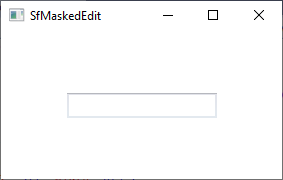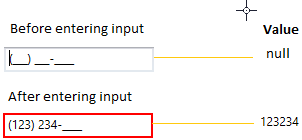Getting Started with WPF MaskedTextBox (SfMaskedEdit)
18 Feb 202510 minutes to read
This section explains how to create a WPF MaskedTextBox (SfMaskedEdit) and explains about its structure and features.
Control Structure

Assembly deployment
Refer to the control dependencies section to get the list of assemblies or NuGet package that needs to be added as reference to use the control in any application.
You can find more details about installing the NuGet package in a WPF application in the following link:
Adding WPF SfMaskedEdit via designer
You can add the SfMaskedEdit control to an application by dragging it from the toolbox to a view of the designer. The following dependent assembly will be added automatically.
- Syncfusion.SfInput.WPF
- Syncfusion.SfShared.WPF

Adding WPF SfMaskedEdit via XAML
To add the SfMaskedEdit control manually in XAML, follow these steps:
-
Create a new WPF project in Visual Studio.
-
Add the following assembly references to the project,
- Syncfusion.SfInput.WPF
- Syncfusion.SfShared.WPF
-
Import Syncfusion® WPF schema http://schemas.syncfusion.com/wpf and declare the
SfMaskedEditcontrol in XAML page. -
Declare the
SfMaskedEditcontrol in XAML page.<Window xmlns="http://schemas.microsoft.com/winfx/2006/xaml/presentation" xmlns:x="http://schemas.microsoft.com/winfx/2006/xaml" xmlns:syncfusion="http://schemas.syncfusion.com/wpf" x:Class="SfMaskedEditSample.MainWindow" Title="SfMaskedEdit Sample" Height="350" Width="525"> <Grid> <!--Adding SfMaskedEdit control --> <syncfusion:SfMaskedEdit x:Name="sfMaskedEdit" Width="100" Height="25" /> </Grid> </Window>
Adding WPF SfMaskedEdit via C#
To add the SfMaskedEdit control manually in C#, follow these steps:
-
Create a new WPF application via Visual Studio.
- Add the following assembly references to the project,
- Syncfusion.SfInput.WPF
- Syncfusion.SfShared.WPF
-
Include the required namespace and create an instance of
SfMaskedEditand add it to the window. -
Declare the
SfMaskedEditcontrol using C#.using Syncfusion.Windows.Controls.Input; public partial class MainWindow : Window { public MainWindow() { InitializeComponent(); //Creating an instance of SfMaskedEdit control SfMaskedEdit sfMaskedEdit = new SfMaskedEdit(); sfMaskedEdit.Width = 100; sfMaskedEdit.Height = 25; //Adding SfMaskedEdit as window content this.Content = sfMaskedEdit; } }

NOTE
View Sample in GitHub
Restrict the user to enter valid data
You can restrict the user to enter the valid input without any custom validation by creating the mask pattern as your requirement. You can enable the mask by setting the mask pattern to the Mask property and set the MaskType property value as Regex. The default value of Mask property is null and MaskType property is Simple.
<syncfusion:SfMaskedEdit Mask="-?\d+\.?\d*"
MaskType="RegEx"
Name="sfMaskedEdit"/>SfMaskedEdit sfMaskedEdit = new SfMaskedEdit();
sfMaskedEdit.MaskType = MaskType.RegEx;
sfMaskedEdit.Mask = @"-?\d+\.?\d*";
Here, the SfMaskedEdit accept the positive and negative whole or float type numbers.
NOTE
Please refer the Restrict the user to enter valid data page to know more about the various mask pattern with examples.
NOTE
View Sample in GitHub
Setting the value
You can set the value for the SfMaskedEdit by using the Value property. Based on the mask, the value of Value property is formatted. The default value of Value property is null.
<syncfusion:SfMaskedEdit Value="4553456789"
Mask="\([0-9]\d{2}\) [0-9]\d{2}-[0-9]\d{3}"
MaskType = "RegEx"
Name="sfMaskedEdit"/>SfMaskedEdit sfMaskedEdit = new SfMaskedEdit();
sfMaskedEdit.Value="4553456789";
sfMaskedEdit.MaskType = MaskType.RegEx;
sfMaskedEdit.Mask = @"\([0-9]\d{2}\) [0-9]\d{2}-[0-9]\d{3}";
NOTE
View Sample in GitHub
Get the value in various formats
By default, the Value property holds your input characters, prompt characters, and the literals defined in the mask. You can modify this and allow the Value property to hold the characters without prompt and literals by setting the ValueMaskFormat property. The value can be formatted by any one of the following formatting options,
- ExcludePromptAndLiterals
- IncludeLiterals
- IncludePrompt
- IncludePromptAndLiterals
<syncfusion:SfMaskedEdit ValueMaskFormat="ExcludePromptAndLiterals"
Mask="\([0-9]\d{2}\) [0-9]\d{2}-[0-9]\d{3}"
MaskType = "RegEx"
Name="sfMaskedEdit"/>SfMaskedEdit sfMaskedEdit = new SfMaskedEdit();
sfMaskedEdit.ValueMaskFormat = MaskFormat.ExcludePromptAndLiterals;
sfMaskedEdit.MaskType = MaskType.RegEx;
sfMaskedEdit.Mask = @"\([0-9]\d{2}\) [0-9]\d{2}-[0-9]\d{3}";
NOTE
View Sample in GitHub
Indicates error on invalid input
After input validation failed, you can indicate to the user about the invalid input by the showing error border. The error border automatically disappeared when the input validation is succeed. You can change the error border color by using the ErrorBorderBrush property. The default value of ErrorBorderBrush property is Red.
<syncfusion:SfMaskedEdit ErrorBorderBrush="Yellow"
Name="sfMaskedEdit"/>SfMaskedEdit sfMaskedEdit = new SfMaskedEdit();
sfMaskedEdit.ErrorBorderBrush = Brushes.Yellow;
NOTE
View Sample in GitHub
Indicates the missed input
You can indicate to the user to enter the missed input by using the prompt character. You can change the prompt character by using the PromptChar property. The default prompt character is _.
<syncfusion:SfMaskedEdit PromptChar="X"
MaskType="RegEx"
Mask="\+1 [0-9]\d{2}-[0-9]\d{2}-[0-9]\d{3}"
Name="sfMaskedEdit"/>SfMaskedEdit sfMaskedEdit = new SfMaskedEdit();
sfMaskedEdit.PromptChar = 'X';
sfMaskedEdit.MaskType = MaskType.RegEx;
sfMaskedEdit.Mask = @"\+1 [0-9]\d{2}-[0-9]\d{2}-[0-9]\d{3}";
NOTE
View Sample in GitHub
Value changed notification
you can notified when changing the value of SfMaskedEdit.Value property by using the ValueChanged event.
NOTE
Your valid input character is updated to the
Valueproperty based on theValidationModeproperty.
Refer Input Validation to know more about theValidationMode.
<syncfusion:SfMaskedEdit ValueChanged="SfMaskedEdit_ValueChanged"
Name="sfMaskedEdit"/>SfMaskedEdit sfMaskedEdit = new SfMaskedEdit();
sfMaskedEdit.ValueChanged += SfMaskedEdit_ValueChanged;You can handle the event as follows,
private void SfMaskedEdit_ValueChanged(object sender, EventArgs e) {
MessageBox.Show("Value changed");
}Theme
SfMaskedEdit supports various built-in themes. Refer to the below links to apply themes for the SfMaskedEdit,

NOTE
View Sample in GitHub